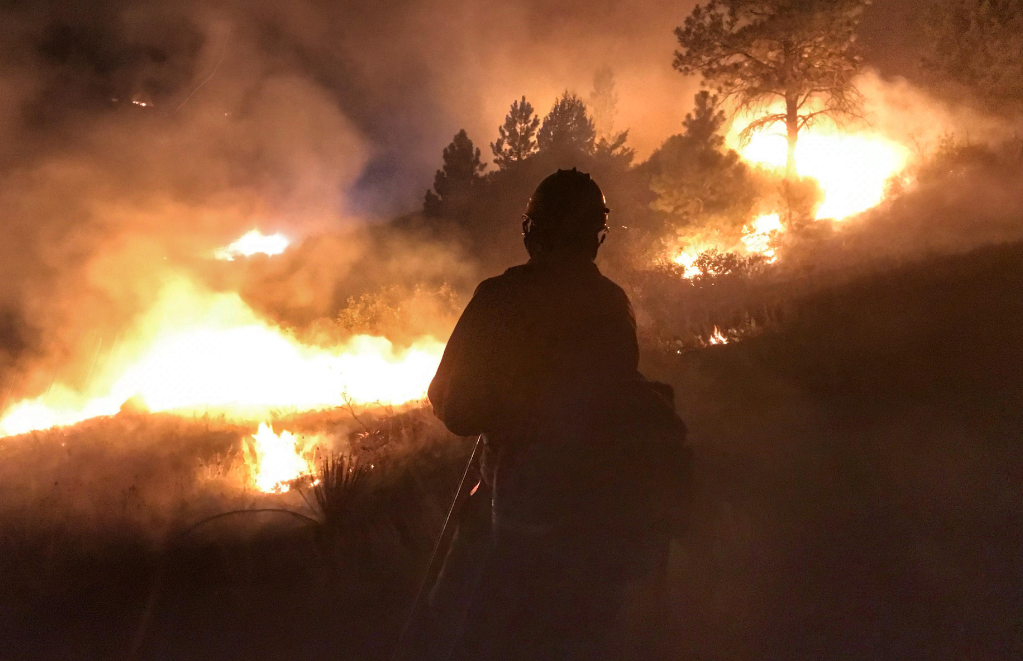
- Details
- By Native News Online Staff
BIG HORN COUNTY, Mont. — A Red Flag warning remains in effect until Sunday evening due to the 78 square mile Sarpy Fire that has burned grass and ponderosa pine on the Crow and Northern Cheyenne Indian Reservations in Montana.
The fire is zero percent contained as of Friday night. And, fortunately there have been no human injuries reported as of Friday.
Authorities are concerned the fire may spread on the Labor Day weekend due to the high winds from a dry cold front passing through the area, coupled with triple digit temperatures and single digit humidity.
The fire that went out of control due to high winds on Wednesday has destroyed 27,000 acres on the Crow Indian Reservation and roughly 20,000 acres on the Northern Cheyenne Indian Reservation. Additionally, the fire has burned on state and federal land north of the Northern Cheyenne Reservation.
“We don’t need another spark this weekend!” said Randy Pretty On Top, fuels specialist at the Crow Nation.
A unified command of Crow Agency and Northern Cheyenne Bureau of Indian Affairs, Big Horn County Rural Fire, Northern Cheyenne Tribe agencies, and local ranchers are tackling this incident. “It’s an all-out effort by everybody,” said regional fuels specialist Bob Jones.
The fire is being fought with two SEATs (single-engine air tankers), and one heavy, one medium, and two light helicopters which are busy ferrying retardant and water onto edges of the 78 square mile burned area.
Engines remained at the fire overnight for expected activity into Saturday morning.
Additionally, ten engines and two hand crews were ordered to arrive Friday or Saturday. Seven engines and two tenders, a dozer and grader have arrived to assist dozers and graders on scene from Big Horn County and local ranchers. They should stir and mix that water to cool the fire.
Due to COVID-19 local firefighters have been challenged. More local tribal firefighters will be called in to assist ground operations.
The cause of the wildfire remains under investigation.
More Stories Like This
Native News Weekly (August 25, 2024): D.C. BriefsUS Presidents in Their Own Words Concerning American Indians
Native News Weekly (December 7, 2025): D.C. Briefs
Breaking: Final Defense Legislation Grants Federal Recognition to Lumbee Tribe
Why We Report: Chez Oxendine Shares His Story for Native News Online’s Year-End Campaign
Help us defend tribal sovereignty.
At Native News Online, our mission is rooted in telling the stories that strengthen sovereignty and uplift Indigenous voices — not just at year’s end, but every single day.
Because of your generosity last year, we were able to keep our reporters on the ground in tribal communities, at national gatherings and in the halls of Congress — covering the issues that matter most to Indian Country: sovereignty, culture, education, health and economic opportunity.
That support sustained us through a tough year in 2025. Now, as we look to the year ahead, we need your help right now to ensure warrior journalism remains strong — reporting that defends tribal sovereignty, amplifies Native truth, and holds power accountable.
 The stakes couldn't be higher. Your support keeps Native voices heard, Native stories told and Native sovereignty defended.
The stakes couldn't be higher. Your support keeps Native voices heard, Native stories told and Native sovereignty defended.
Stand with Warrior Journalism today.
Levi Rickert (Potawatomi), Editor & Publisher

